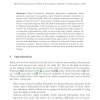Free Online Productivity Tools
i2Speak
i2Symbol
i2OCR
iTex2Img
iWeb2Print
iWeb2Shot
i2Type
iPdf2Split
iPdf2Merge
i2Bopomofo
i2Arabic
i2Style
i2Image
i2PDF
iLatex2Rtf
Sci2ools
90
Voted
ACCV
2007
Springer
2007
Springer
Comparative Studies on Multispectral Palm Image Fusion for Biometrics
Hand biometrics, including fingerprint, palmprint, hand geometry and hand vein pattern, have obtained extensive attention in recent years. Physiologically, skin is a complex multi-layered tissue consisting of various types of components. Optical research suggests that different components appear when the skin is illuminated with light sources of different wavelengths. This motivates us to extend the capability of camera by integrating information from multispectral palm images to a composite representation that conveys richer and denser pattern for recognition. Besides, usability and security of the whole system might be boosted at the same time. In this paper, comparative study of several pixel level multispectral palm image fusion approaches is conducted and several well-established criteria are utilized as objective fusion quality evaluation measure. Among others, Curvelet transform is found to perform best in preserving discriminative patterns from multispectral palm images.
ACCV 2007 | Computer Vision | Hand Vein Pattern | Level Multispectral Palm | Multispectral Palm Images |
Related Content
| Added | 07 Jun 2010 |
| Updated | 07 Jun 2010 |
| Type | Conference |
| Year | 2007 |
| Where | ACCV |
| Authors | Ying Hao, Zhenan Sun, Tieniu Tan |
Comments (0)

